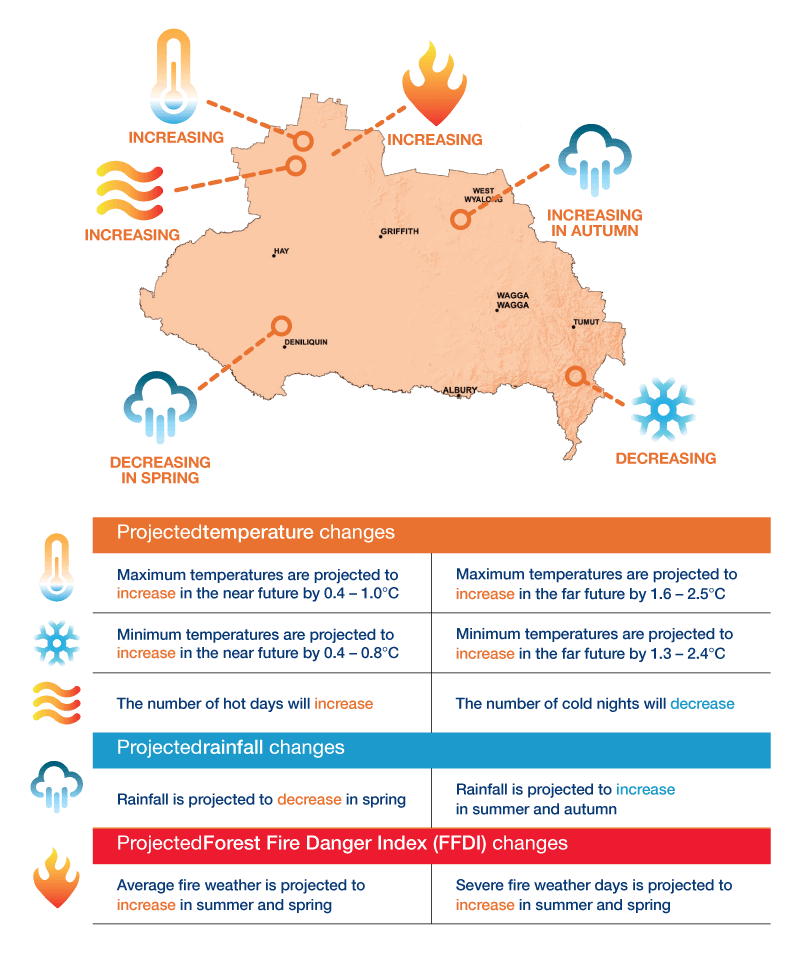Dealing with the impacts of climate variability is a challenge for our whole community. We need to prepare for increasing variability in our region’s climate and make ourselves more resilient to extreme weather.
It’s never been more important to get together as a community and help each other manage and bounce back from climate-related challenges.
Albury Climate Projections
The NSW Office of Environment and Heritage (AdaptNSW) has developed climate projections for the Murray Murrumbidgee region covering rainfall, fire, heat, and cold nights. It gives projections for the near future (2020–2039, or 2030) and for the far future (2060–2079, or 2070), compared to 1990–2009.

Why Adaptation Matters
Managing climate risk is about being ready to adapt to changes. For future generations in Albury and the region to enjoy the quality of life and experiences we currently have, we need to become more resilient to the impacts of climate variability.
To be more resilient, we need to be well prepared to adapt when changes happen.
What we are doing
Climate risk assessment
In 2012 we carried out a climate risk assessment . This clearly showed that that higher temperatures would have an impact on our community, particularly its more vulnerable members. It also highlighted how important water quality is to our region economically, as we rely so much on Murray River tourism.
Integrated Regional Vulnerability Assessment
In 2013 we participated in the Integrated Regional Vulnerability Assessment project for the Riverina Murray Region. The state government ran a series of workshops across the region, each focusing on a particular theme: landscapes and ecosystems; industries, settlements and infrastructure; human services; and emergency management.
Safeguarding communication infrastructure against extreme heat
A Building Resilience to Climate Change grant of $64,000 was used to design, manufacture and install heat-resistant cabinets. Each of the new cabinets for the stations now include cooling fans, activated when the internal temperature reaches 38 degrees Celsius. The cabinets also have airflow to promote circulation and have auxiliary power generators so that if there is a network power failure, the stations can continue to operate. The cabinets have been powder-coated in a reflective colour to reduce heat retention and the need for ongoing maintenance.
Monitoring has been established for four sites that were upgraded as a result of the grant, through automated system alerting of the links and connection status, along with associated equipment temperatures. Data is recorded on an ongoing basis and any conditions outside operating parameters prompts an escalation to IT operational staff.
Enabling Regional Adaptation project
In 2015 we were part of NSW Enabling Regional Adaptation, which is about finding pathways to resilient community, environmental and economic systems.
ClimateWatch
In 2016 the Albury Botanic Gardens participated in ClimateWatch trails. This is an initiative by EarthWatch, the University of Melbourne and the Bureau of Meteorology to get communities involved in recording the local impacts of climate change on plants and animals. Local people collect information, ClimateWatch checks the quality of the data and makes it available on the Atlas of Living Australia. Scientists use this information to keep track of the impacts of climate change across Australia.